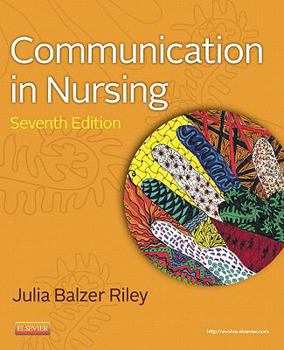Communication in Nursing
Select Format
Select Condition 
Book Overview
Go beyond theory and start to master the essential communication skills and techniques you'll need throughout all areas of nursing practice. Communication in Nursing, 7th Edition uses a personal and empathetic approach, along with unique artistic features, to help you develop a deeper understanding of the importance of communication. Comprehensive, step-by-step guidelines teach you how to establish patient relationships, and new QSEN-specific exercises help you learn to connect more effectively with patients, co-workers, and managers for better clinical outcomes. Real-life clinical scenarios, chapter exercises, and a new writing tutorial also offer endless opportunities to hone your skills.
Moments of Connection boxes highlight the outcomes and benefits of successful communication. Wit & Wisdom boxes provide a humorous, personal approach to communication theory and application. Reflections On. boxes give you a specific task to help you integrate chapter material into the broader scope of nursing practice. Exercises throughout the book help you master chapter techniques and strengthen your communication skills. QSEN-specific exercises developed by a leading expert highlight how safety and improved care can result from better communication. UNIQUE Online writing tutorial on Evolve helps you review and improve your technical writing skills. Case studies on Evolve give you practice using proper communication skills in a variety of real-life case scenarios. The latest information on compassion fatigue, language use, client preconceived ideas about health care, transcultural issues, technology, and the demands of electronic medical record systems provide you with the most up-to-date and relevant information needed to excel in today's nursing field.Format:Paperback
Language:English
ISBN:032308334X
ISBN13:9780323083348
Release Date:December 2011
Publisher:Mosby
Length:368 Pages
Weight:1.35 lbs.
Dimensions:0.6" x 7.5" x 9.3"
Customer Reviews
2 ratings
Used in Nursing 100
Published by Thriftbooks.com User , 19 years ago
Good book, a little wordy and "touchy feely". Used, but not a great deal. Good reference book for Psych, however.
Communication in Nursing 4th ed by Riley
Published by Thriftbooks.com User , 24 years ago
This book has four parts each containing five to ten chapters. Part I: Getting Started includes responsible, assertive, caring communications; helping relationship; mutual problem solving; culture; and electronic communications. Part II: Building Relationships has chapters about warmth, respect, genuineness, empathy, self-disclosure, specificity, asking questions, expressing opinions, humor, and spirituality. Part III: Meeting Challenges deals with confrontation, refusing unreasonable requests, communicating assertively and responsibly with distressed and/or aggressive clients and colleagues and with unpopular clients, and team conflict. Part IV: Building Confidence covers requesting support, evaluation anxiety, feedback, relaxation, imagery, positive self-talk, and commitment. The author explains how to read the book by noting the questions at the end of the chapter, chapter objectives, and bold print. Then think about the answers to questions as the book is read. In the acknowledgments the author identifies content in each part and how it will help the reader. Connecting the content with reasons for learning it helps motivate the learner. Each chapter starts with whimsical animals and inspiring figures art, quotations, and the chapter objectives. Important content is highlighted in tables and boxes. Important points are often bulleted or numbered. Color is used. Multicultural proverbs, wit and wisdom sections, poetry, and moments of connection that share the meaning of nursing through story telling are dispersed throughout the book. Nursing examples are used. Spirituality, humor, and think about it exercises have been added since the last edition. Exercises encourage active learning. References and suggestions are at the end of each chapter, and appendix and index are at the end of the book. This book facilitates multiple intelligences and applies learning theory. Use of this book is an excellent way to teach communication in nursing.






